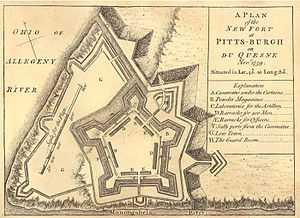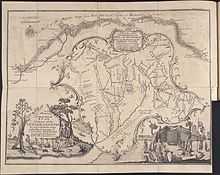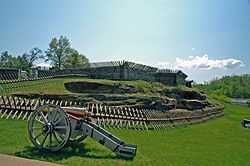Siege of Fort Pitt
- For the 1885 action in the Canadian North-West Rebellion, see the Battle of Fort Pitt
| Siege of Fort Pitt | |||||||
|---|---|---|---|---|---|---|---|
| Part of Pontiac's Rebellion | |||||||
 "A Plan of the New Fort at Pitts-Burgh", drawn by cartographer John Rocque and published in 1765. | |||||||
| |||||||
| Belligerents | |||||||
| Ohio Country natives | Great Britain | ||||||
| Commanders and leaders | |||||||
| Guyasuta |
Simeon Ecuyer William Trent | ||||||
| ||||||
The Siege of Fort Pitt took place in 1763 in what is now the city of Pittsburgh, Pennsylvania, United States. The siege was a part of Pontiac's Rebellion, an effort by American Indians to drive the British out of the Ohio Country and back across the Appalachian Mountains. The Indian effort to capture Fort Pitt ultimately failed. This event is best known for the documented use of biological warfare when the British Army at Fort Pitt fooled and passively attacked the Native Americans with smallpox using blankets that had been exposed to the virus. The attack contributed to the widespread smallpox epidemics that killed much of their population during and after the war.
Background
Fort Pitt was built in 1758 during the French and Indian War, on the site of what was previously Fort Duquesne. The French abandoned and destroyed Fort Duquesne in November 1758 with the approach of General John Forbes's expedition. The Forbes expedition was successful in part because of the Treaty of Easton, in which area American Indians agreed to end their alliance with the French. American Indians—primarily Delawares and Shawnees—made this agreement with the understanding that the British military would leave the area after the war. The Indians wanted a trading post, but they did not want a British fort, or a British garrison, near their villages. The British, however, built Fort Pitt larger and stronger than Fort Duquesne had been.
The Siege
In May 1763, Pontiac's Rebellion began at Fort Detroit. After Indians around Pittsburgh heard the news, they attacked Fort Pitt on June 22, 1763. Too strong to be taken by force, the fort was kept under siege throughout July. Meanwhile, Delaware and Shawnee war parties raided deep into the Pennsylvania settlements, taking captives and killing unknown numbers of men, women, and children. Panicked settlers fled eastwards.
For General Jeffrey Amherst, who before the war had dismissed the possibility that the Indians would offer any effective resistance to British rule, the military situation over the summer became increasingly grim. He wrote his subordinates and instructed them not to take any Indian prisoners.
The siege didn't let up until August 1, 1763, when most of the Indians broke off from Fort Pitt in order to intercept a body of 500 British troops marching to the fort under Colonel Henry Bouquet. On August 5, these two forces met at the Battle of Bushy Run. Bouquet fought off the attack and relieved Fort Pitt on August 20.
Biological warfare
On June 29, 1763, a week after the siege began, Bouquet was preparing to lead an expedition to relieve Fort Pitt when he received a letter from Amherst making the following proposal: "Could it not be contrived to Send the Small Pox among those Disaffected Tribes of Indians? We must, on this occasion, Use Every Stratagem in our power to Reduce them."
Bouquet agreed, writing back to Amherst on July 13, 1763: "I will try to inocculate the Indians by means of Blankets that may fall in their hands, taking care however not to get the disease myself." Amherst responded favorably on July 16, 1763: "You will Do well to try to Innoculate the Indians by means of Blanketts, as well as to try Every other method that can serve to Extirpate this Execreble Race."
As it turned out, however, officers at the besieged Fort Pitt had already exposed the Indians in just the manner Amherst and Bouquet were discussing. During a parley at Fort Pitt on June 24, 1763, Captain Simeon Ecuyer gave representatives of the besieging Delawares two blankets and a handkerchief from the smallpox ward "out of regard to them" after the Delawares pledged to renew their friendship. While the exact meaning of his phrase was unclear, a later invoice appears to clearly establish the purpose was transmittal of smallpox.
Indians in the area did indeed contract smallpox. Some historians have noted that it is impossible to verify how many people (if any) contracted the disease as a result of the Fort Pitt incident; the disease was already in the area and had reached the Indians through other vectors. Indeed, even before the blankets had been handed over, the disease may have been spread to the Indians by native warriors returning from attacks on infected white settlements. The smallpox epidemic that had occurred during Pontiac's War spread to areas/groups such as the Lenni Lenape (Delaware) and Shawnee villages, killing as many as 400,000-500,000 Native Americans during and years after Pontiac's Rebellion.[1][2][3]
Biological Warfare was Ineffective
While no existing evidence supports that this attempt was successful,[4][5] a preponderance of documented evidence suggests that the smallpox among some natives preceded the exchange, was contracted from a different source, and the attempt to "inoculate" the recipients, Turtle's Heart and Mamaltee,[6] was unsuccessful.
Turtleheart and Mamaltee did not get Smallpox
On his own initiative and according to sundries trader and militia Captain, William Trent, on June 24, 1763, Captain Ecuyer, gave two blankets, one silk handkerchief and one linen from the smallpox hospital,[7] to two Delaware delegates, Turtleheart, a principal warrior, and Maumaultee, a Chief.[8]
Smallpox (variola major) usually has an incubation period of less than two weeks before eruptions appear on the skin. On July 26, 1763, a full month later, an Indian delegation, Turtleheart and Maumaultee among them, came back to the Fort, under a flag of truce, to parley.[9]
Turtleheart And Killbuck would later represent the Delaware Nation at the Treaty of Fort Stanwix in 1768[10]
Smallpox Preceded the Exchange of 24 June 1763

Thomas Hutchins, in his August 1762 Journal entry among the Natives at Fort "Mineamie", reports: "The 20th, The above Indians met, and the Ouiatanon Chief spoke in behalf of his and the Kickaupoo Nations as follows: '"Brother, We are very thankful to Sir William Johnson for sending you to enquire into the State of the Indians. We assure you we are Rendered very miserable at Present on Account of a Severe Sickness that has seiz'd almost all our People, many of which have died lately, and many more likely to Die."
Later, Hutchins writes "The 30th, Set out for the Lower Shawneese Town' and arriv'd 8th of September in the afternoon. I could not have a meeting with the Shawneese untill the 12th, as their People were Sick and Dying every day."[11]
Gershom Hicks, taken captive in May 1763 by the Shawnee and Delaware people reported that the epidemic was well underway, among the natives, since spring of 1763. Hicks escaped and arrived to Fort Pitt on April 14, 1764 and reported to the 42nd Regiment Captain, William Grant, "that the Small pox has been very general & raging amongst the Indians since last spring and that 30 or 40 Mingoes, as many Delawares and some Shawneese Died all of the Small pox since that time, that it still continues amongst them."[12]
Smallpox from a Different Source
John McCullough, was a Delaware captive, since July, 1756, who was then 15 years old, wrote that "Soon after we got home to Mahoning, instead of taking me to Pittsburgh, agreeable to their promise, they set out on their Fall hunt, taking me along with them; we staid out till some time in the Winter before we returned" He continues that, on June 2, 1763,[13][14] "Shortly after the commencement of the war, they plundered a tanyard near to Pittsburgh, and carried away several horse-loads of leather;",[15][16] and recalled that, beginning on July 5th, 1763,[17] the Lenape people, under the leadership of Shamokin Daniel, "committed several depredations along the Juniata; it happened to be at a time when the smallpox was in the settlement where they were murdering, the consequence was, a number of them got infected, and some died before they got home, others shortly after; those who took it after their return, were immediately moved out of the town, and put under the care of one who had the disease before."[18][19]
No Remarkable Connection
With the vast wealth of contemporary eyewitness accounts from the French, British and Native Camps, none make mention of an outbreak in the July, 1763 (two weeks after the exchange) except John McCullough - who claimed, verifiably so, that the Delaware contracted it in the Juniata River Valley.[20][21]
Mary Jemison, a Seneca captive, was captured in 1755, in what is now Adams County, Pennsylvania, from her home along Marsh Creek. She married to a Delaware, and later chose to remain with the Seneca over liberation. In James E. Seaver's (Jemison's biographer) interview, she describes her many hardships including travels to Fort Pitt. In her 7th year of captivity, (1762) she reports the death of her first husband from "sickness" - but makes no mention of smallpox among her adoptive people.[22]
Notes
- ^ Peckham, p. 226; Anderson, p. 542; 809n.
- ^ Anderson, p. 809n.
- ^ Anderson, p. 809n.
- ^ Anderson, pp. 541–2; McConnell, p. 195; Dowd, War Under Heaven, p. 190.
- ^ Harpster, pp. 99, 103-4.
- ^ Fenn, paragraph 4.
- ^ Fenn, paragraph 5.
References
- ↑ Crawford, Native Americans of the Pontiac's War, 245–250
- ↑ Phillip M. White (June 2, 2011). American Indian Chronology: Chronologies of the American Mosaic. Greenwood Publishing Group. p. 44.
- ↑ D. Hank Ellison (August 24, 2007). Handbook of Chemical and Biological Warfare Agents. CRC Press. pp. 123–140. ISBN 0-8493-1434-8.
- ↑ http://www.nativeweb.org/pages/legal/amherst/34_40_305_fn.jpeg (pg. 95)
- ↑ Ecuyer, Simeon: Fort Pitt and letters from the frontier (1892)Captain Simeon Ecuyer's Journal: Entry of June 24,1763
- ↑ Ecuyer, Simeon: Fort Pitt and letters from the frontier (1892)Captain Simeon Ecuyer's Journal: Entry of June 24,1763
- ↑ Fenn, Elizabeth A. Biological Warfare in Eighteenth-Century North America: Beyond Jeffery Amherst
- ↑ Ecuyer, Simeon: Fort Pitt and letters from the frontier (1892)Captain Simeon Ecuyer's Journal: Entry of June 24,1763
- ↑ Trent, William, Journal of William Trent, 1763 from Pen Pictures of Early Western Pennsylvania, John W. Harpster, ed. (University of Pittsburgh Press, 1938), pp. 99, 103-4.
- ↑ Proceedings of Sir William Johnson with the Indians at Fort Stanwix to settle a Boundary Line. 1768
- ↑ Hanna, Charles A.:The wilderness trail : or, the ventures and adventures of the Pennsylvania traders on the Allegheny path, with some new annals of the old West, and the records of some strong men and some bad ones (1911) pg.366
- ↑ Burke, James P., Pioneers of Second Fork (pgs. 19-22)
- ↑ McCullough, John: The Captivity of John McCullough Personally written after eight years of captivity.
- ↑ Ecuyer, Simeon: Fort Pitt and letters from the frontier (1892)Journal of Captain Simeon Ecuyer Entry June 2, 1763
- ↑ McCullough, John: The Captivity of John McCullough Personally written after eight years of captivity.
- ↑ Ecuyer, Simeon: Fort Pitt and letters from the frontier (1892)Journal of Captain Simeon Ecuyer: Entry of July 22, 1763
- ↑ Ellis, F. and Hungerford, A.N.(Editors).History of that part of the Susquehanna and Juniata Valleysembraced in the counties of Mifflin, Juniata, Perry, Union and Snyder, in the commonwealth of Pennsylvania Published 1886 by Everts, Peck & Richards in Philadelphia.
- ↑ McCullough, John: http://The Captivity of John McCullough Personally written after eight years of captivity.
- ↑ Dixon, David, Never Come to Peace Again: Pontiac's Uprising and the Fate of the British Empire in North America (pg. 155)
- ↑ McCullough, John: http://The Captivity of John McCullough Personally written after eight years of captivity.
- ↑ Dixon, David, Never Come to Peace Again: Pontiac's Uprising and the Fate of the British Empire in North America (pg. 155)
- ↑ Seaver James E.A Narrative of the Life of Mrs. Mary Jemison(1824)
- Anderson, Fred. Crucible of War: The Seven Years’ War and the Fate of Empire in British North America, 1754-1766. New York: Knopf, 2000. ISBN 0-375-40642-5.
- Dixon, David. Never Come to Peace Again: Pontiac's Uprising and the Fate of the British Empire in North America. Norman: University of Oklahoma Press, 2005. ISBN 0-8061-3656-1.
- Dowd, Gregory Evans. War Under Heaven: Pontiac, the Indian Nations, & the British Empire. Johns Hopkins University Press, 2002. ISBN 0-8018-7079-8.
- Fenn, Elizabeth A. Biological Warfare in Eighteenth-Century North America: Beyond Jeffery Amherst. The Journal of American History, Vol. 86, No. 4, March, 2000. link
- Harpster, John W. Pen Pictures of Early Western Pennsylvania University of Pittsburgh Press, 1938
- McConnell, Michael N. A Country Between: The Upper Ohio Valley and Its Peoples, 1724-1774. Lincoln, Nebraska: University of Nebraska Press, 1992.
- Peckham, Howard H. Pontiac and the Indian Uprising. University of Chicago Press, 1947.
External links
- "Colonial Germ Warfare", article from Colonial Williamsburg Journal
| ||||||||||||||||||||||||||||
